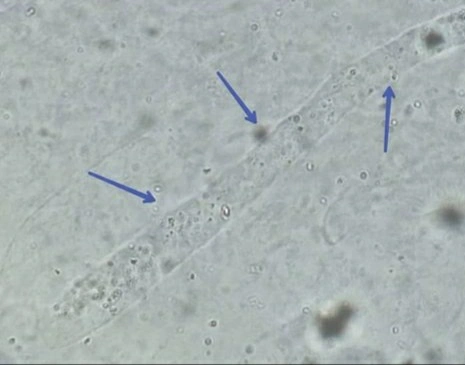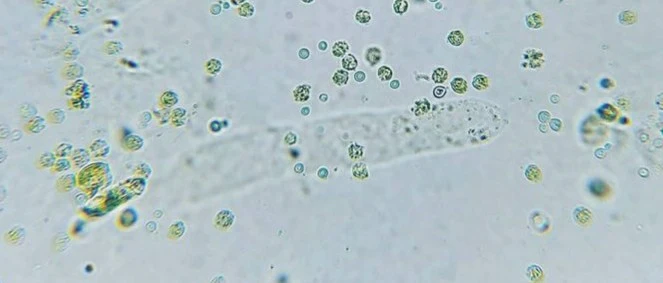Sommaire :
◉ Définition
Hyaline casts are tiny, microscopic, tube-like structures found in urine and composed primarily of a protein called "Tamm-Horsfall".
Non-specific, Hyaline casts can be found in normal healthy subjects, in individuals suffering from pathological conditions or after taking certain medications.
These casts are best identified by a phase contrast microscopy where they can display an array of morphologies.
The Hyaline Cast is considered the fundamental structural unit of all urinary casts.

◉ Description of Hyaline casts
Hyaline casts have an acellular matrix, clear with a low refractive index and can easily go unnoticed when examined under a bright field microscopy or on an aged specimen where dissolution has occurred.
They are best identified by a phase contrast microscopy. Generally, hyaline casts have transparent, empty appearance, smooth texture, parallel sides with clear margins and blunt ends.

Note : Reduced lighting can help to better see these casts.
◉ Clinical significance of Hyaline casts in urine
Hyaline casts may be present in low numbers (0-1/LPF) in the concentrated urine of otherwise normal.
They are not always associated with kidney disease. Low urine output, concentrated urine or an acidic environment can contribute to their production :
- Intense physical exercise.
- Fever
- Severe vomiting
- Dehydration
- Diuretic treatment
However, these casts can be the consequence of a pathological situation (renal or extra-renal) and help guide the diagnosis:
- Acute glomerulonephritis
- Pyelonephritis
- Chronic renal failure
- Congestive heart failure
- Spillover proteinuria (multiple myeloma)
Note : Large amounts of hyaline casts may indicate kidney damage due to decreased blood flow to the kidneys.
◉ Other types of urine casts
There are several different types of casts that can be found in urine, each of which can indicate different underlying conditions. Some other common types of casts found in urine include :
- Red blood cell casts : These casts are formed when RBCs leak from the glomerular capillaries and become trapped in the kidney tubules. Most often signify the presence of a proliferative glomerulonephritis.
- Granular casts : These casts contain granular material and may be composed of either cellular debris or protein aggregates. granular casts are typically associated with acute tubular injury (ATI)
- Fatty casts : are seen in people who have lipids in urine. This is most often a complication of nephrotic syndrome
- Waxy casts : referred to those presented with a homogeneous melted wax appearance. Waxy casts can be found in people with advanced renal disease and long-term kidney failure.
◉ Frequently Asked Questions
Is hyaline cast in urine normal ?
Hyaline casts can be seen in small numbers in healthy individuals, their presence in large numbers may indicate a renal disease. If you have concerns about the presence of these casts in your urine, it is important to consult a doctor for further evaluation and diagnosis.
How to see hyaline cast ?
Hyaline casts in urine are not visible to the naked eye and can only be detected using a microscope in a laboratory.
How do you treat hyaline casts ?
Hyaline casts are not a disease or condition on their own, the treatment for these casts will depend on the underlying cause (ex : dehydration, increasing fluid intake may be recommended). Your healthcare provider will determine the underlying cause of the hyaline casts and recommend an appropriate course of treatment.
What is Tamm-Horsfall protein ?
Also known as uromodulin, is a glycoprotein produced exclusively by renal tubular epithelial cells within the distal loop of Henle. Uromodulin has been implicated in the pathophysiology of multiple kidney diseases.
What are cellular casts ?
Cellular casts are cylindrical structures formed by the accumulation of various types of cells and other substances. There are several types of cellular casts, including red blood cells casts, white blood cells casts, and epithelial cell casts.